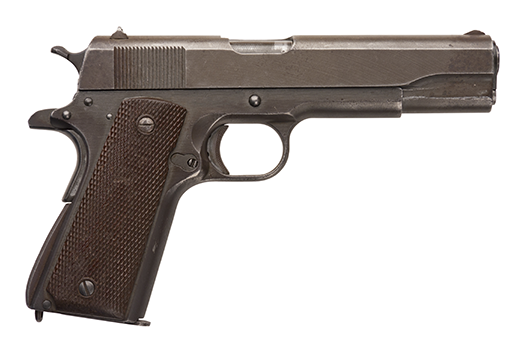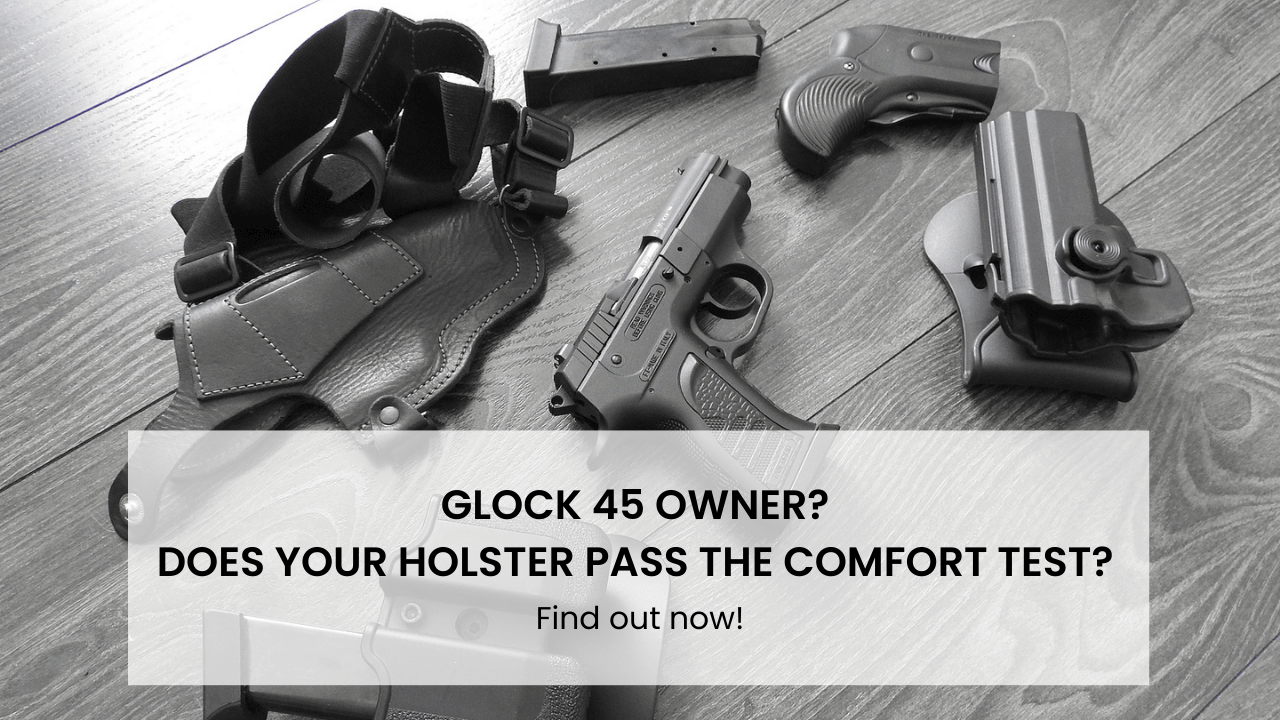What’s the Best Type of 1911 Concealed Carry Holster?
Apr 24th 2021

The M1911 remains one of America’s most beloved handguns, despite its age. Adopted in the year of its namesake by the United States Army, this 110-year-old handgun design continues to be a popular choice for concealed and open carry, home defense, competition shooting, such as IPSC and IDPA, and even hunting.
OWB Single Magazine Carrier Holster
The 1911
Following its adoption, the M1911 and its later variant, the M1911A1, served as the official sidearm of the United States armed forces until 1985, when the Beretta M9 replaced it. The M9, chambered in 9×19mm Parabellum and fed from a 15-round magazine, was more suitable for NATO standardization.
The M1911 is a semi-automatic, recoil-operated, single-action-only handgun. Although initially chambered in .45 ACP and fed from a 7-round magazine, there are 1911-pattern handguns chambered in various cartridges, including 9mm, .40 S&W, 10mm Auto, and others. Gun owners carry handguns based on the 1911 platform for a variety of reasons.
Many find its design highly ergonomic, with the width and angle of the grip, the upswept beavertail safety that’s become the standard, and the placement of the controls, allowing for easy handling. The single-action-only (SAO) trigger tends to be relatively light and crisp without adjustment: a definite improvement in relation to many striker-fired handguns.
Its continued popularity is also cultural. As a further illustration of the pistol’s legacy, the governor of Utah designated the 1911 as the official state firearm on the 100th anniversary of its adoption.
1911 Variants

The best type of 1911 holster depends on the variant. 1911 pistols are available in the following configurations:
Government Model
This is the full-size 1911, featuring a 5” barrel and weighing approximately 38 oz. Full-size handguns, such as the Government Model 1911, may be more suitable for strongside holsters than appendix carry.
Commander
The Commander represents the first compact variant of the pistol platform, introduced in 1950, which sports a 4¼” barrel. Originally featuring an aluminum frame, rowel-type hammer, and rat-tail grip safety, modern variants remain popular for practical purposes. You can find Commander-type pistols with either aluminum or steel frames and chambered in 9mm or .45 from various reputable manufacturers.
Officer’s ACP
This model is considered a type of subcompact 1911, featuring a 3½” barrel. The frame is also shorter, which reduces the extent to which the pistol prints through clothing compared with the Commander. However, it also reduces gripping surface, and consequently, control.
Officer’s ACP pistols chambered in .45 ACP can be more difficult to control, especially during rapid fire. If you intend to carry a pistol of this type, it’s vital that you practice. Subcompact 1911 pistols also tend to be less reliable than their full-size counterparts, so fire a sufficient number of rounds through yours to ensure reliable operation before carrying.
Long Slide
Some companies manufacture 1911 pistols with 6” and 7” barrels. The most well-known example of a long-slide 1911 is probably the AMT Hardballer, featured in the first Terminator film (1984).
Holster Selection
There are various holster types to choose from, depending on several different factors. One of the first decisions you’ll have to make is whether you want to carry in an IWB or OWB holster.
Inside-the-waistband (IWB) holsters are designed for deep concealment, hiding the gun below your belt line and under your pants. IWB holsters typically attach to the belt using clips that attach to the belt in several ways. However, IWB is generally less comfortable with full-size handguns.
Outside-the-waistband (OWB) holsters are suitable for concealed and open carry, are more comfortable to wear and are generally less difficult to draw from. However, you’ll need to wear a cover garment for concealment. OWB holsters usually attach using belt loops.
Material
When you’re searching through the holsters on the market, one type of material that you will commonly see is Kydex. Through a custom thermoforming process, Kydex holsters conform to the gun’s slide and frame contours, ensuring a snug fit.
While not as soft or as comfortable to wear as leather, Kydex is more durable, retaining its shape and resisting collapse or deformation. Unlike some leather holsters, you won’t have to keep the holster open with your left hand when reholstering. This minimizes the chance that you’ll cover yourself.
As Kydex is harder on the finish of your firearm, you should ensure there’s no dirt or foreign matter inside the holster. The friction can accelerate wear and tear.
One of the most significant advantages of Kydex in comparison with leather is that it’s impervious to water, oil, or chemical cleaning products. As a result, Kydex won’t warp, swell, or retain water, protecting your weapon against the environment.
Retention
Most Kydex holsters use a passive retention system, which relies on friction from custom molding to secure your firearm. If you’re practicing IWB carry, passive retention is commonplace and arguably ideal because it’s fast and simple.
Your draw stroke requires that you achieve a full firing grip and pull upward sharply. You don’t need to manipulate a button, lever, or other device to unlock the pistol. This reduces the probability of failure under stress.
Many passive-retention holsters feature one or more screws that you can tighten or loosen to adjust the retention, finding the perfect balance between ease of draw and security.
If you plan to carry your 1911 openly, you may consider a holster with an active-retention system as an additional layer of security. Passive retention is less effective at resisting unauthorized access, which is why law-enforcement personnel routinely use a thumb break or other device to retain the weapon.
Sweat Shield
Modern semi-automatic tactical pistols and revolvers are either stainless steel or benefit from a special corrosion-resistant coating. However, many 1911 pistols only have a finish consisting of bluing or zinc/manganese phosphating to protect the steel slide and barrel from rust.
As a result, it’s even more imperative to avoid exposing your 1911 pistol to the corrosive effects of human perspiration. That’s what a sweat shield or guard is for — the part of the holster that acts as a barrier between the slide and your body.
A sweat shield also protects your body from the firearm, as a hot slide from a practice session at the range can be uncomfortable when pressed against you.
Trigger Guard
It is critical that the holster you select for your 1911 pistol fully covers the trigger guard. When you place your hand on the pistol, your index finger should lay straight against the outside of the holster.
It should be impossible for your finger to enter the trigger guard until the pistol has fully cleared the holster. A holster with a covered trigger guard not only helps you observe essential firearms safety rules but also protects the trigger from interference.
Reholstering Your 1911
The act of reholstering a 1911, or any firearm, has a high risk attached to it. As you return your weapon to its holster, applying downward pressure, anything that can enter the trigger guard and interfere with the trigger can cause a potentially life-threatening unintentional discharge.
One of the culprits is loose clothing entering the holster without the shooter noticing. Another is a holster that has deteriorated due to frequent use. Always be mindful of the condition of your holster and how your clothing falls in relation to it.
The most crucial element to safe reholstering is your vigilance. You should practice the act of reholstering slowly and carefully. You should only reholster your firearm if the threat for which you are preparing has ceased. If there’s no threat, there’s no need to reholster with competition-level urgency. The number of unintentional discharges on firing ranges stemming from reholstering mishaps is excessive and preventable.
A Word on Alternative Holsters
Under certain specialized circumstances, a non-waistband holster can be beneficial. However, for general use, an IWB or OWB holster is preferable on your strongside or in the appendix position, affording a practical balance of speed and concealment.
You may have wondered whether you should wear a 1911 in a shoulder holster. While there may be specialized applications for a shoulder holster, waistband holsters are generally more practical. Many firing ranges and shooting schools prohibit the use of shoulder holsters for safety reasons, limiting your training opportunities. It’s also slower to draw from and requires that you wear a jacket or coat to conceal it.
Magazine Carriers
In an age of double-stack semi-automatic pistols, the 1911 is a decidedly low-capacity platform with magazines typically holding between seven and nine rounds. This is all the more reason to carry spare magazines in a pouch on your belt.
Parting Thoughts
At Incognito Concealment, we appreciate the classic 1911 pistol and why gun owners choose this weapon for self-defense. If you’d like to discuss 1911 holsters and carry methods, call us at (586) 999-5820.











